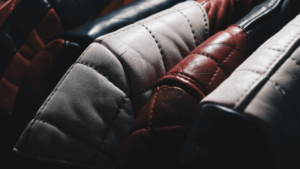5 Reasons Dogs Lick Leather Couch/Sofa
Why does my dog lick my leather sofa? And should I be worried about it?
Dogs lick things. We all know this. It’s something they do when they’re exploring their environment or just out of boredom.
But sometimes, this ”common behavior” can get you worried because leather is a delicate material and your sofa might get damaged.
In this article, we’ll take a look at the reasons dogs lick leather and other objects. In addition, we’ll give you some tips on what to do if you’re concerned about your pet’s licking behavior.

Why does my dog lick my leather sofa?
A dog might lick a leather sofa or furniture for a number of reasons. It could be that the leather has a strange smell or taste that the dog is curious about. It could also be that the dog is trying to get attention, seeking comfort, feeling stressed and anxious, or just bored and lonely.
Let’s see how these factors promote your pet’s furniture-licking behavior.
1. Strange smell or taste on the sofa
Dogs are known for their uncanny ability to sense when something isn’t quite right.
So, if your dog is licking your leather sofa, it’s likely because something about it doesn’t smell or taste right to them. It could be that the leather is treated with a chemical that’s off-putting to dogs, something spilled on the sofa, or the couch is flea infested.
Either way, the dog will keep licking until the smell on the leather sofa or taste disappears. Therefore, it’s best to have the sofa cleaned as soon as possible before the leather gets damaged.
2. Your dog is stressed or anxious
As any pet owner knows, dogs can be prone to licking furniture especially when they’re feeling stressed or anxious.
If your dog is licking your sofa excessively, it’s essential to take a step back and assess the situation.
Are there any changes in the home that could be causing stress, such as a new baby or pet? Is your dog getting enough exercise?
By taking a closer look at the reasons behind the licking, you can help your dog feel more relaxed and content. Also, consult your veterinarian or a certified animal behaviorist to get professional help.
3. When feeling lonely or bored
There’s no doubt that dogs are social creatures. They thrive on companionship and love to be around people. So it’s not surprising that when they are left alone, they can get lonely and bored.
One way they may express this is by licking things – including your leather sofa. While it may seem like harmless behavior, it can actually damage the leather over time.
If you think your dog is licking out of loneliness or boredom, try providing more interaction and stimulation.
Take them for walks, play games with them, and ensure they have plenty of different toys to keep them entertained.
4. The dog is seeking attention
Licking can also signify affection or attention-seeking behavior among dogs and pets in general.
If your dog starts licking leather furniture especially when you are around, it may be trying to get your attention.
As mentioned earlier, dogs are very social and thrive on positive reinforcement from their owners. This is why they often try to give you a little love by licking your face or hand when they want some love back.
5. Its a self-soothing behavior
Some dogs may also lick leather furniture as a way to self-soothe.
Dogs have a natural instinct to groom themselves and their owners. When they are nervous or anxious, they may lick their lips or yawn to self-soothe.
Leather furniture provides a smooth surface for them to do this. When dogs groom themselves, they are not only cleaning their fur but also stimulating their skin.
According to American Kennel Club, repetitive licking relaxes the dog and releases endorphins, which have a calming effect.
Licking leather furniture is also a way for dogs to create a scent marker. This allows them to claim their territory and make it feel more like home.
How to get my dog to stop licking the couch
As any pet owner knows, it can be difficult to keep your furry friend from chewing on your furniture. Whether it’s a brand-new leather or fabric sofa, or an antique chair, there’s always the risk that your beloved pet will take a nibble.
And while a few teeth marks might not seem like a big deal, over time they can start to wear away at the leather, causing irreversible damage.
Whatever the reason, there are a few things you can do to deter your dog from licking your leather furniture.
-
New toys and games
When is the last time you bought new toys or games for your pet?
Playing with the same toys every day can get quite boring over time. So it is important to provide your dogs with plenty of toys, games, and playtime to keep them occupied.
This will redirect their attention away from the sofa since they will have something else to focus on. Also, it will help keep them entertained and prevent boredom and loneliness.
-
Positive reinforcement
You can also train your dog not to lick furniture by using positive reinforcement.
Positive reinforcement is a dog training technique that uses rewards to increase the likelihood of the desired behavior. Rewards can be anything your dog enjoys, such as treats, petting, or playtime.
If you catch your dog in the act, say “No” firmly and redirect their attention to a toy or treat. With patience and training, your dog will learn that licking the leather sofa is not allowed
Additionally, when you see your dog not licking your furniture even without your intervention, reward them immediately.
This positive reinforcement will help your dog learn and remember the desired behavior.
-
Bitter spray deterrent
Another solution is to try spraying the leather with a bittering agent to deter dogs from licking leather.
Bitter apple spray is one such product that is available at most pet stores. The unpleasant taste stops the dogs from licking or chewing things around the house and especially furniture.
The downside is that the dog may eventually learn to ignore the bitter taste, or may simply lick it off of the furniture. In either case, you’ll need to continue using the deterrent on a regular basis.
-
Cover the leather sofa
Another option is to cover the furniture with a couch cover, sheet, or blanket that can be easily washed when it becomes soiled.
The cover will not only protect your furniture from being licked but also keep your dog from jumping up on the furniture and scratching it with his nails.
It’s also important to keep your dog’s nails trimmed so they don’t damage the leather.
In addition, learn a few tricks to keep the couch covers in place so as to protect your leather sofa.
-
Designated licking surface
Another way is to create a designated area for them to lick. You can purchase a Dog Licking Surface or make your own using a flat surface that is sturdy and easy to clean.
Keep the licking surface in an area where your dog has easy access to it. This will help to redirect their attention away from the furniture and protect it from being stained or damaged by their saliva.
Always remember to clean it regularly to prevent bacteria build-up.
-
Consult an animal behaviorist or veterinarian
If all else fails, consult with a veterinarian or animal behaviorist to get to the root of the problem and find a lasting solution.
Conclusion
Regardless of the reason, excessive licking can damage leather furniture and should be discouraged.
While it’s important to provide your dog with plenty of toys and attention, sometimes even the best-behaved pooches can’t help but lick the couch when they are lonely or bored.
If you think your dog is licking the leather sofa due to boredom, try adding some new toys or puzzles to their routine.
Also, it’s important to keep your dog’s nails trimmed and use a couch cover to protect leather furniture when necessary.
You can also discourage your dog from licking the leather by spraying it with a bitter spray or another pet-safe deterrent. Another option is to consider using positive reinforcement to stop your dog from licking furniture.
If you’re unsure why your dog is licking leather furniture, consult with a veterinarian or animal behaviorist for help.




